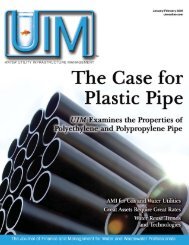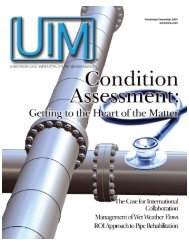Download - Water Utility Infrastructure Management
Download - Water Utility Infrastructure Management
Download - Water Utility Infrastructure Management
You also want an ePaper? Increase the reach of your titles
YUMPU automatically turns print PDFs into web optimized ePapers that Google loves.
uption to streets, pedestrians and traffic installation costs tendto be less expensive and at a lower energy price as well.The long-term service life of plastic pipe systems alsoenhances its sustainability. Since polyethylene pipe does notrust, it s resistant to tuberculation in water pipes. Thesetubercles are small mounds of ferric compounds that form onthe inside of steel or iron pipes. As these tubercles grow, theyroughen the inside of the iron pipe, increasing its resistanceto water flow and decreasing pipe capacity and its projectedservice life. Storm water systems are also subjected to harshchemicals and aggressive flow conditions. Polyethylene isunaffected by roadway salts, brackish water and other roadwaypollutants. It also demonstrates better resistance to abrasionthan concrete or metal, making it not only an acceptablechoice for storm water systems but also a preferred materialfor use in aggressive drainage applications.PE pressure pipe and storm sewer pipe have calculatedservice lives of well over 100 years and at the end of its servicelife, PE pipe can be recycled or used as a fuel source forwaste to energy systems.What is the most common misconception about plasticpipe? How do you seek to educate end-users about them?Because of plastic pipe’s light weight and flexibility thereis a belief it is not strong enough to handle the application.This is contradictory to fact when one considers the marketof share plastic pipe. Those designers and specifiers whohave already used plastic pipe have recognized its significantfeatures and benefits. For others, we continue to presentrelative data and case studies, either in person, at tradeshows or through media outlets to create a better awarenessof plastic pipe and how it has been used successfully in theUnited States and around the globe.What decision-making criteria should an end-userconsider when making a purchasing decision regardingpipe materials?In all candor, the first criterion is to have an open mind whenconsidering pipe materials. Familiarity brings contentment butnot necessarily the best product for the job. Advances in materials,especially plastics, are quite dynamic and provide solutionsto recurrent and vexing problems. The second criterion is anhonest and in-depth assessment of performance life. Thisrequires a full understanding (or projection) of the lifetime operatingrequirements and conditions of the pipe system along withawareness of other environmental or extraneous conditions. Forexample, what are the required hydraulic demands for the systemand will the system still meet those requirements throughoutits lifetime? What effect will corrosion, tuberculation androot infiltration have? What is the potential for leaks or soil/groundwater infiltration? How does the water chemistry or effluentaffect long-term performance? What are the soil conditionsand is the area prone to ground shift or earthquakes? The thirdcriterion is cost. Like performance life, there are many variablesthat need to be evaluated. Short-term considerations includecost of the pipe and fittings and the cost of installation.Depending on the type of pipe used, there are different optionsavailable, including open-cut and trenchless, that must be evaluated.Are there other installation requirements needed such asthrust blocks for water systems or fusion equipment to join thepipe? Long-term costs relate mostly to maintenance. If the pipeis prone to chemical attack, brittleness or infiltration, what arethe associated costs for repair and cleaning of the lines? TheNovember/December 2010fourth and last criterion must be consideration of the followingquestion: “Without compromising performance of the pipe system,which has the best impact on the environment?” Today’sowners and specifiers have a keener interest in the environmentthan ever before and designers need to be sensitive to this issue.Plastic pipe is often the best solution.How is the current economy affecting the pipe market?What are the short- and long-term prospects?Housing starts plays a key role in the demand for pipe.As an early economic indicator, our industry started seeingthe effects of the slowdown in 2006. Site development forutility installations including water, sewer, storm and gas wasdramatically hit in 2007 and of course 2008 when the wheelsfell off of the entire economy. Fortunately we serve manyother industries including oil and gas gathering and geothermalsystems that have been exceptionally strong overthe last few years. Like many other industries, we have seena rebound in 2010 and are cautiously optimistic that theongoing economic recovery will continue to increase demandfor pipe. Longer term we see the replacement market forwater, sewer and storm water systems as a significant growthopportunity. Trenchless installation, specifically pipe bursting,will be significant in the demand for PE pipe.What effect, if any, has the American Recovery andReinvestment Act (ARRA) had on the pipe market? Whatabout the water/wastewater market in general?Unfortunately from our standpoint, ARRA has a negligibleeffect for plastic pipe. It seems underground infrastructure hastaken a back seat to the more visible road work and other aboveground construction projects. Our research indicates that asignificant amount of this money has yet to be spent but we arestill not counting on any significant impact. We see moreopportunity in Clean <strong>Water</strong> State Revolving Funds andDrinking <strong>Water</strong> State Revolving Funds (SRFs). These SRFshave proven to be some of the most successful federal programsfor providing financial assistance combined with stateand local control of spending priorities. Administered throughEPA, these federally supported programs provided approximately$6 billion for wastewater and $1.4 billion for drinkingwater in fiscal year 2010. In light of the projected $540 billiongap estimated by the EPA, this is a mere drop in the bucket forwhat is truly needed. If Congress would increase the amount ofthese low interest, flexible loans we would see a tremendousincrease in demand for plastic pipe.Plastic pipe, particularly HDPE, is commonly used intrenchless installations. What trends have you seen regardingthe use of trenchless? What impact do these trendshave on the pipe market?As the awareness and acceptance of trenchless installationincreases, so does the confidence in this technique and the useof PE pipe. Starting with smaller diameter pipe (4-inch andunder) we are now seeing larger diameter pipe systems employingthis installation process. Gas utilities have been using trenchlessfor quite some time and many of the gas utility contractorsare now bidding more and more for municipal water projects.We are also seeing some assimilation between gas and waterutilities, which further brings trenchless awareness to the watermarket. As this trend continues, we anticipate increasing demandfor trenchless and for PE pipe.<strong>Water</strong> <strong>Utility</strong> <strong>Infrastructure</strong> <strong>Management</strong> 37








